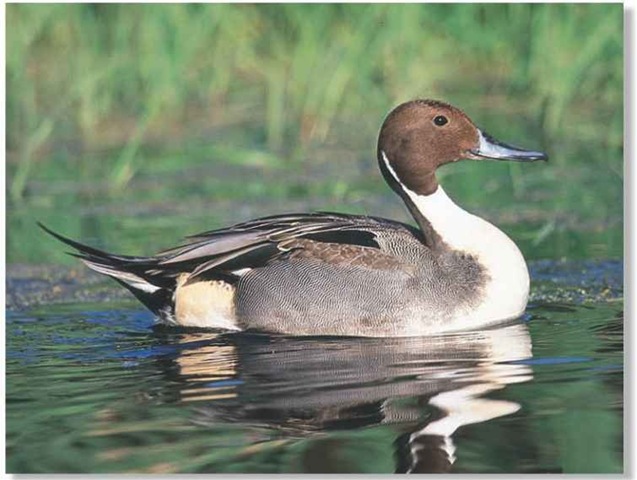ORDER
Anseriformes
FAMILY
Anatidae
GENUS & SPECIES
KEY FEATURES
Most widely distributed duck in North America; one of the most numerous ducks in the world
Averages over 100 miles per day on long migratory flights that often exceed 2,000 miles
Named for its “pintail,” the elongated tail feathers that can measure up to 4″ long in males
WHERE IN THE WORLD?
Found throughout the Northern Hemisphere; breeds across Canada, the U.S., Europe and Asia; also winters in South America, Africa, and India
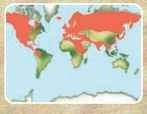
LIFECYCLE
Female and male pintails resemble each other when the male molts; when his new handsome plumage grows in, he migrates south a month ahead of the female.
HABITAT
From the tundra to the tropics,the northern pintail is widespread and numerous. The pintail’s two basic requirements for any home are water, shallow enough for feeding, and low vegetation on the shores. It is most abundant on prairie and tundra habitats that offer open vistas with quiet and shallow marshes, rivers or lakes. Freshwater is preferred over brackish. In Alaska, thousands of small ponds are home to one or more pairs. Pintails usually remain on ponds near the coasts, but in India, large numbers are found on inland lakes. On the sea, the birds form flocks of over 1,000, which split up into small parties that mingle with other ducks.
Moving day Millions of pintails migrate each spring and fall.
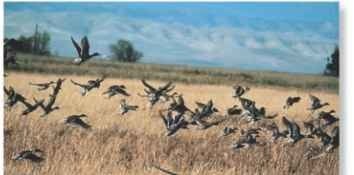
CONSERVATION
The pintail is not endangered; over 6 million pintail breed in the U.S. alone. But hunting and drainage are contributing to a slow decline of many ducks.The pintail is a popular target for hunters; in fact, it is among the top three, along with mallards and teal.The draining of marshes and shallow lakes is continuing at an alarming rate, reducing breeding and nesting grounds.
BEHAVIOR
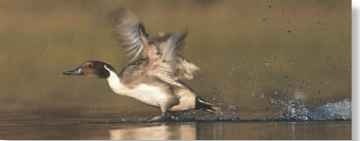
A Aquatic runway
The pintail has large wings for strong, fast flight.
From mid-July to early September, the male pintail, or drake, molts, trading his handsome plumage for a
plainer set of feathers called eclipse plumage. The pintail molts all of its flight feathers simultaneously, rendering it flightless. To compensate, the male assumes the overall coloration of the camouflaged female. During this vulnerable flightless period, a pintail will only dive fully underwater in an attempt to escape danger. The males molt first into their winter plumage and begin their long migratory journey south; the females follow a month later. The pintail accurately retraces the same migratory flyways in the fall that it followed in the spring. Flight speeds reach over 50 mph, but the young have less endurance and require more frequent stops than the adults. Only those pintails in parts of the western U.S. and Europe remain in the same place throughout the winter
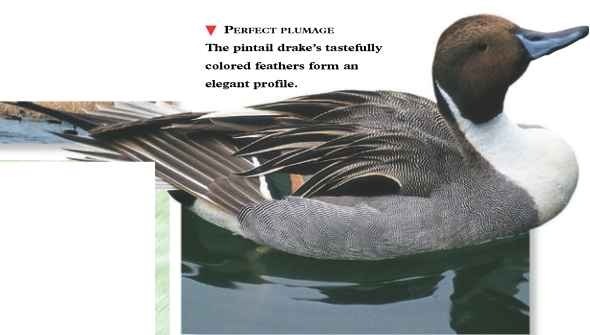
FOOD & FEEDING
The northern pintail is an opportunistic feeder, using a variety of techniques to exploit all that its shallow, aquatic habitat has to offer The pintail’s flexible neck, serrated bill and webbed feet enable it to skillfully swim across shallow waters and surface-feed on seeds, grasses, insects and tadpoles. But the long neck offers an additional payoff: the pintail can feed in relatively deep waters by up-ending. Powerful, paddling legs help the duck keep its balance, while it reaches up to 12″ below the surface. Spending up to 6 seconds underwater, the pintail searches for snails, mollusks, crabs and seeds along the muddy bottom and often uproots pondweed and sedge plants.
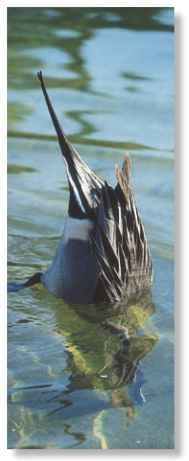
BREEDING
The most common male courtship display is a call known as “burping” — a geee sound that changes to a soft, flutelike whistle. Males burp, then perform a “head-up-tail-up” display, with their long tails pointing straight up. Once she has chosen a mate, the female builds a down-lined hollow in the ground among low plants. She lays one egg per day, but does not start her lone incubation until the full clutch of 7-9 eggs is laid. Often the male stays with her to help guard the exposed nest and to accompany her to the water with the chicks. Female pintails are fearless in the defense of their young, attempting to combat much larger predators. But less than half of the chicks survive to breed the following year because of natural predators and hunters.
Downy soft
All chicks hatch together after an incubation of about 23 days.
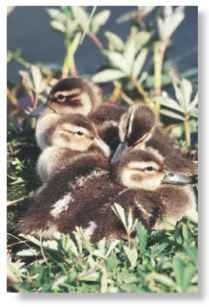
FLEXIBLE FEEDERS
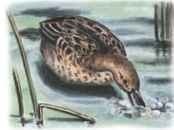
Dabbling…
The pintail is a dabbling (surface-feeding) duck.A female sieves aquatic plant matter with the help of serrations on her bill.
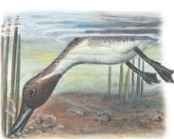
Head-dipping…
The pintail can also extend its neck into the shallow waters to reach various submerged plants, found just below the surface.

Up-ending…
To reach the tubers of aquatic plants, the female submerges the front of her body, while her tail remains visible above the surface.
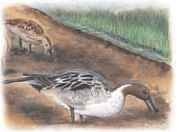
Grazing
The pintail’s feet are set farther forward than those of diving ducks, so it can wander comfortably over nearby pasture.
The northern pintails in Europe migrate as far south as the Sudan and are depicted in ancient Egyptian paintings.
When foraging for seeds in the water, the pintail may accidentally ingest spent lead shots from hunters; many pintail succumb to lead poisoning each year.
PROFILE
Northern Pintail
The pintail’s slim neck and streamlined body make an elegant profile; when swimming or flying, its distinctive tail feathers are easily identified.
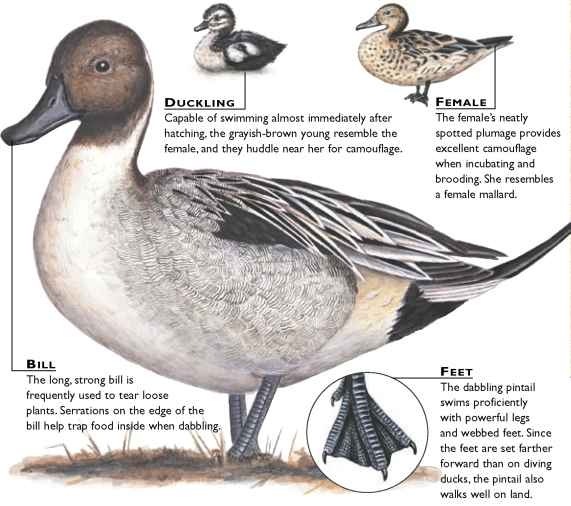
CREATURE COMPARISONS
At 23″ and 2 lbs., the long-tailed duck (Clangula hyemalis) is slightly smaller than the pintail. Only the male has the extended tail feathers. But both sexes have distinct summer, eclipse and winter plumages, which are among the most complex series of plumage patterns of any bird. Unlike the dabbling pintail, the long-tailed duck is a diver It forages for food in deeper water than any other duck diving up to 50′ or more.The most numerous of all arctic breeding ducks, the long-tailed duck swallows shellfish whole; the shells are ground in its gizzard.
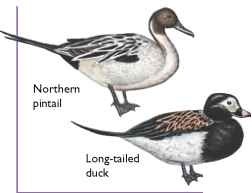
| VITAL STATISTICS Weight 1-3 lbs.; male averages 2.3 lbs., female averages 1.9 lbs. i |
|
| Length | Male 20-29″; female 17-25″ |
| Sexual Maturity | 1 year |
| Breeding Season | April-July |
| Number of Eggs | 7-9 |
| Incubation Period | 22-24 days |
| Fledging Period | 5-7 weeks |
| Breeding Interval | 1 year |
| Typical Diet | Grasses, seeds, tubers, tadpoles, insects and mollusks |
| Lifespan | Up to 27 years |
RELATED SPECIES
• The pintail is 1 of 36 species of dabbling, or surface-feeding, ducks in the genus Anas, which also includes the mallard, A. platyrhynchos, teals and shovelers. Geese and swans join dabbling and diving ducks in the family Anatidae; all are considered true waterfowl. This family is 1 of 2 families comprising about 40 genera and over 140 species in the order Anseriformes.
